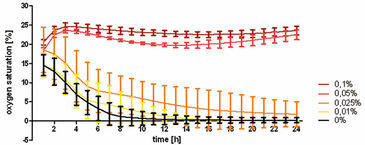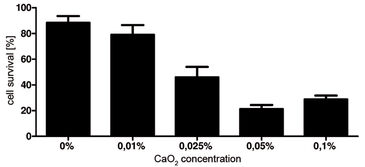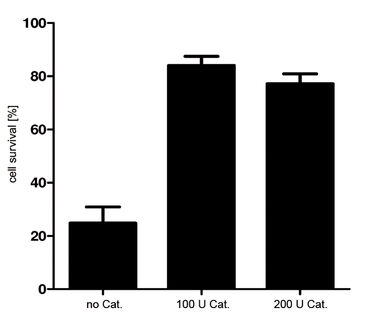Watch tutorials, webinars and informative videos about PreSens optical sensor systems.
Hydrogels as Cell Carriers for Tissue Engineering
Calcium Peroxide Used as an Oxygen Releasing Additive
Uta Leicht1, Elias Volkmer1,Hinrich Wiese2, Matthias Schieker1
1Experimental Surgery and Regenerative Medicine, Department of Surgery, LMU Munich, Germany; 2Polymaterials AG, Kaufbeuren, Germany
Hydrogels might be a new method for cell-based regenerative therapy. They can be applied in a minimal invasive way but they have to be biodegradable and nontoxic. The biocompatibility of different hydrogels seeded with hMSCs was tested in this study. CaO2 served as an oxygen releasing additive in the gels to overcome oxygen limitations or gradients within the gels. The hydrogels used might be suitable for the future injection of cells in damaged tissue. CaO2 seems to be an outstanding oxygen releasing additive but cytotoxic side effects are a problem.
Gel-based cell application could be a new and innovative method for healing of tissue defects. Hydrogels mostly consist of aqueous media which are combined with a polymer. They are an alternative to solid cell seeded scaffolds which require surgical application, while gels could be applied minimally invasive by injection. A limiting factor in using hydrogels as cell carriers is the limited oxygen supply to the cells after application of the gel. Adding oxygen releasing additives into the carriers might help overcome oxygen limitation or gradients within the gels. In this study the biocompatibility of different biodegradable hydrogels was tested. The gels are temperature responsive: the polymer is added to culture medium and cells are integrated at room temperature. The solution remains liquid until heated to body temperature - then the gel starts to solidify. CaO2 was used as an oxygen releasing additive to enhance the oxygen supply to the cells. The resulting formation of H2O2 lowered the cell survival rate dramatically. To prevent this effect, catalase was added together with CaO2 and tests were repeated. Monitoring of the oxygen saturation within the gels was performed using needle-type chemical optical sensors by PreSens.
Materials & Methods
Hydrogels were made by dissolving polyurethanes in culture medium. The polyurethanes used in these experiments were made of polyoxamers and diisocyanatobutane (BDI) or hexamethylendiisocyanate (HMDI). 1.5 x 106 immortalized hMSCs were added per 1 mL of the gel solution. After 24 hours in the incubator cell survival was determined by live/dead-assays using propidium iodide and fluorescein diacetate. Using the gel type with the higher cell survival (BDI) CaO2 was added in different concentrations as an oxygen releasing additive. Detailed oxygen monitoring was performed for 24 hours using needle-type oxygen microsensors by PreSens (Regensburg, Germany). After 24 hours of oxygen monitoring cell survival was determined by live/dead-assays. Tests were repeated adding catalase to the gel solution and using the most promising CaO2 concentration determined in the previous tests.
CaO2 as an Oxygen-Releasing Additive
Cell survival was relatively high in gels without any additives; in BDI-based gels it was 84.0 ± 7.3 % and in HMDI-based gels 67.1 ± 20.3 %. When CaO2 was added to the gels even in low concentrations a considerable increase in oxygen saturation could be measured (Fig. 1). The live/dead-assays though showed that cell survival decreased in the gels with CaO2 (Fig. 2). A reason for the decrease in cell survival might have been the formation of H2O2. That is why catalase together with CaO2 was added to the gels and the tests were repeated. By adding catalase cell survival could be kept at about the same level as in BDI-based gels without any additives (Fig. 3).
Conclusion
Both hydrogels might be suitable for cell injection in damaged tissue. Also the tests showed that CaO2 is a good additive enhancing oxygen saturation in the gels, however cytotoxicity is a problem. Adding catalase dramatically reduced cell death in gels with CaO2. Further studies will have to address long-term cell survival in vitro before in vivo tests can be performed.
Applicaiton note adapted from Leicht et al., 2010, Polyoxamer-based hydrogels made with different chain extenders as oxygen releasing cell carriers for tissue engineering, 14th Annual Meeting on Surgical Research, Langenbeck´s Archives of Surgery, Volume 395, No. 6





